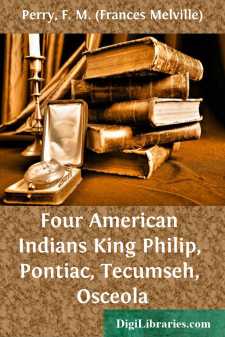Categories
- Antiques & Collectibles 13
- Architecture 36
- Art 48
- Bibles 22
- Biography & Autobiography 813
- Body, Mind & Spirit 142
- Business & Economics 28
- Children's Books 17
- Children's Fiction 14
- Computers 4
- Cooking 94
- Crafts & Hobbies 4
- Drama 346
- Education 46
- Family & Relationships 57
- Fiction 11829
- Games 19
- Gardening 17
- Health & Fitness 34
- History 1377
- House & Home 1
- Humor 147
- Juvenile Fiction 1873
- Juvenile Nonfiction 202
- Language Arts & Disciplines 88
- Law 16
- Literary Collections 686
- Literary Criticism 179
- Mathematics 13
- Medical 41
- Music 40
- Nature 179
- Non-Classifiable 1768
- Performing Arts 7
- Periodicals 1453
- Philosophy 64
- Photography 2
- Poetry 896
- Political Science 203
- Psychology 42
- Reference 154
- Religion 513
- Science 126
- Self-Help 84
- Social Science 81
- Sports & Recreation 34
- Study Aids 3
- Technology & Engineering 59
- Transportation 23
- Travel 463
- True Crime 29
Four American Indians King Philip, Pontiac, Tecumseh, Osceola
Categories:
Description:
Excerpt
I. PHILIP'S PEOPLE
A GRAND SACHEMPhilip, ruler of the Wampanoags, was the only Indian in our country to whom the English colonists gave the title of king. Why no other Indian ever received this title I cannot tell, neither is it known how it happened to be given to Philip.
The Wampanoags were a tribe of Indians whose homes were in what is now southeastern Massachusetts and in Rhode Island east of Narragansett Bay. A few of them, also, lived on the large islands farther south, Nantucket and Martha's Vineyard.
Three centuries ago Massasoit, Philip's father, was the grand sachem, or ruler, of the Wampanoags. His people did not form one united tribe. They had no states, cities, and villages, with governors, mayors, and aldermen, as we have. Nor did they live in close relations with one another and vote for common officers.
On the other hand, they lived in very small villages. A few families pitched their wigwams together and lived in much the same way as people do now when they camp out in the summer.
Generally, among the Wampanoags, only one family lived in a wigwam. The fathers, or heads of the families in the different wigwams, came together occasionally and consulted about such matters as seemed important to them.
Every one present at the meeting had a right to express his opinion on the question under consideration, and as often as he wished. All spoke calmly, without eloquence, and without set speeches. They talked upon any subject they pleased, as long as they pleased, and when they pleased.
The most prominent person in a village was called the sagamore. His advice and opinion were generally followed, and he governed the people in a very slight manner.
The Indians of several villages were sometimes united together in a petty tribe and were ruled by a sachem, or chief.
The chief did not rule over a very large tract of country. Generally none of his subjects lived more than eight or ten miles away from him.
WIGWAMSHe ruled as he pleased, and was not subject to any constitution or court of any kind. In fact, he was a leader rather than a ruler. Nevertheless, a wise chief never did anything of great importance without first consulting the different sagamores of his tribe.
The chief held a little higher position in the tribe than the sagamore did in his village. He settled disputes. He held a very rude form of court, where justice was given in each case according to its merits. He sent and received messengers to and from other tribes.
As several villages were united in a single petty tribe, so also several petty tribes were loosely joined together and ruled over by a grand sachem.
The different Wampanoag tribes which owed allegiance to Philip and his father, Massasoit, were five in number besides the small bands on the islands of Nantucket and Martha's Vineyard. The village where the grand sachem lived was called by them Pokanoket.
Massasoit had several children. The eldest son was named Wamsutta, and the second Metacomet. In later years, the English gave them the names of Alexander and Philip, which are much easier names for us to pronounce.
INDIAN BABYWe do not know the exact date of Philip's birth, for the Indians kept no account of time as we do, nor did they trouble to ask any one his age. It is probable, however, that Philip was born before 1620, the year in which the Pilgrims settled near the Wampanoags.
Philip spent his boyhood days playing with his brothers and sisters, and with the neighbors' children; for although he was the son of a grand sachem, he had no special privileges above those of the other children around him.
We are apt to think of a prince as a man that does very little work. We expect him to attend banquets, to be dressed in military uniform, with a beautiful sword at his side and many medals on his breast, to be surrounded by servants, and to have everybody bow down to him and stand ready to do his bidding....


